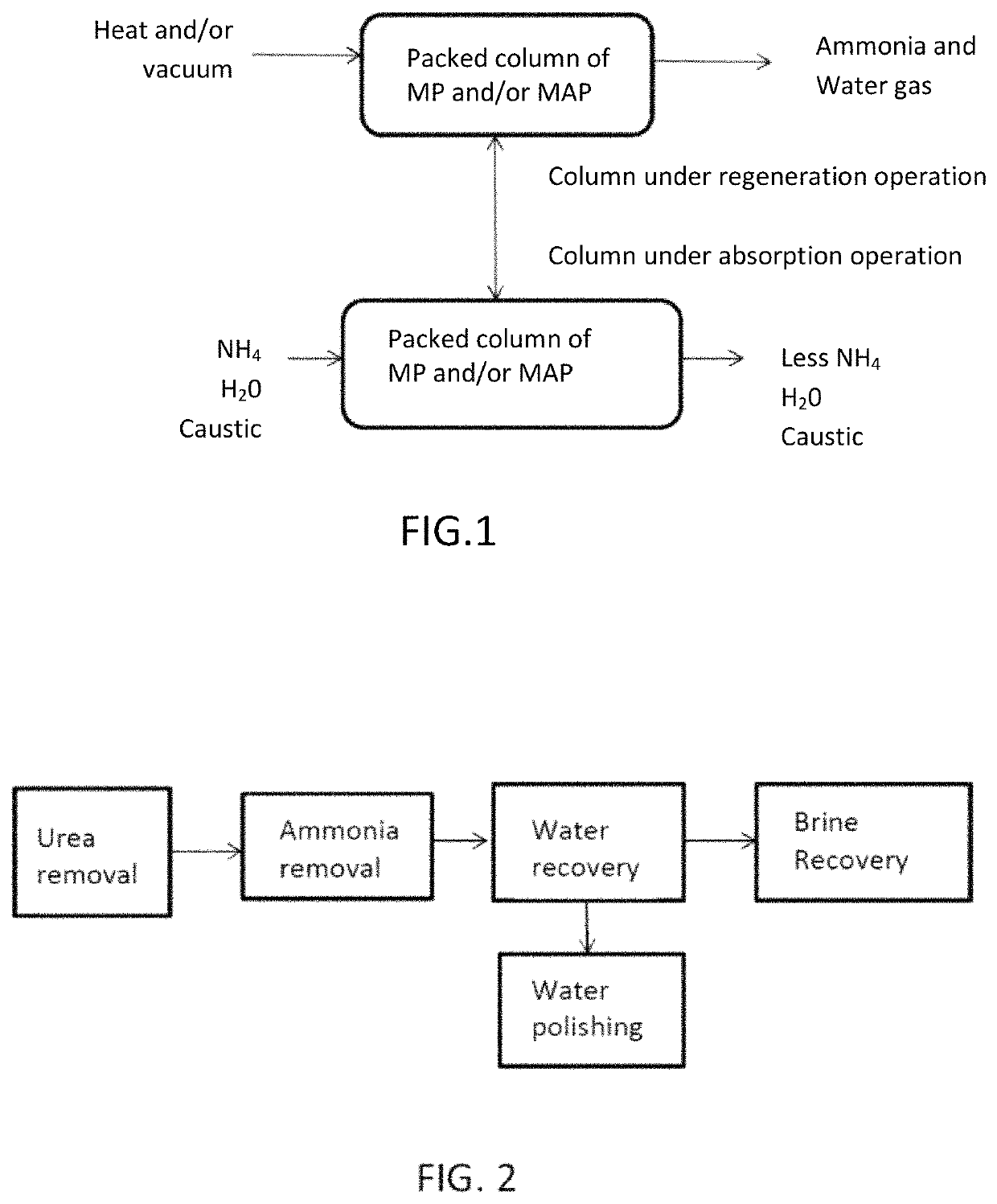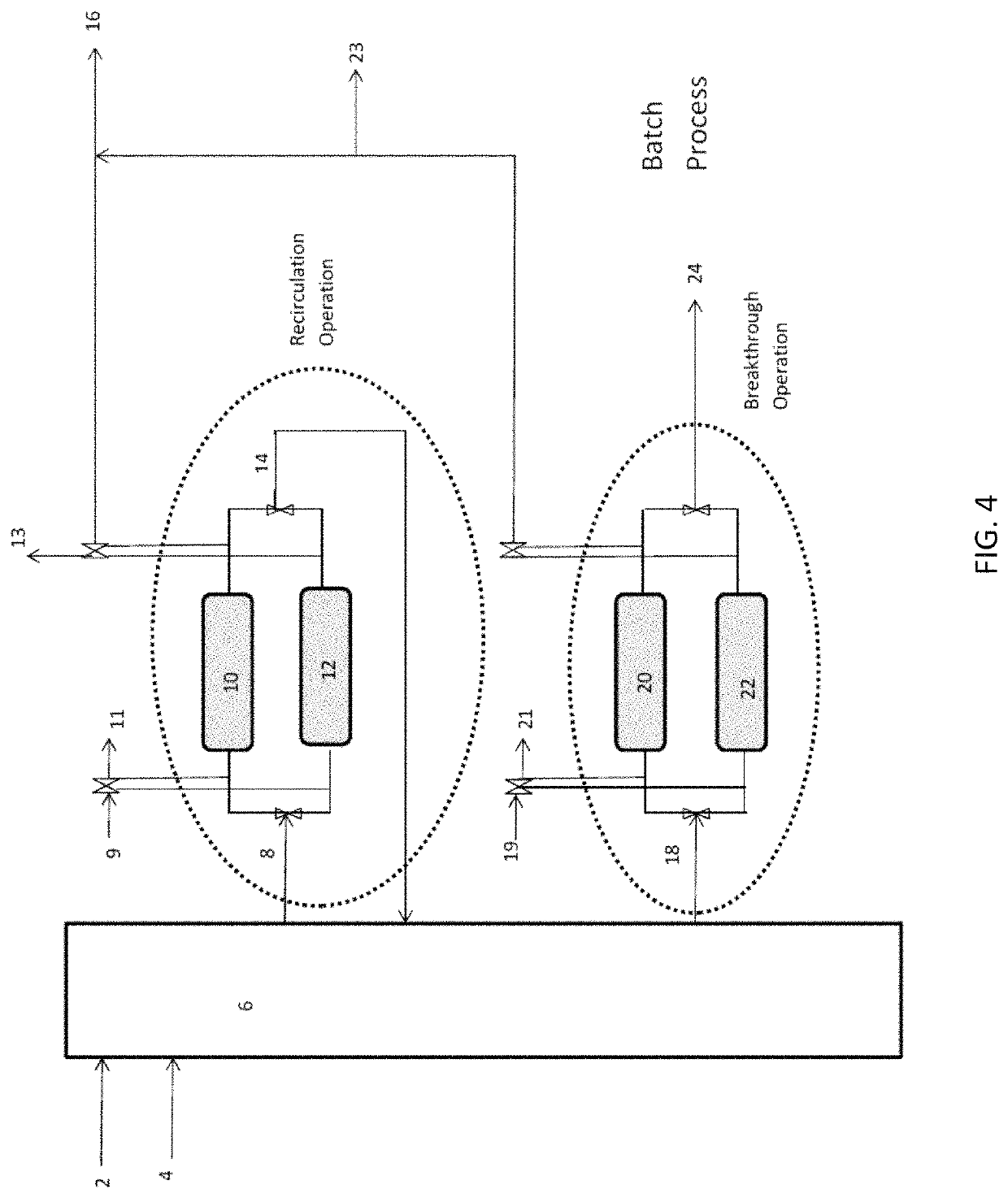Ammonia capture and recovery system and method for removing ammonia from a wastewater stream
a technology of ammonia capture and recovery system, applied in water/sewage treatment by neutralisation, water treatment parameter control, specific water treatment objectives, etc., to achieve the effect of reducing the dissolved solids, reducing the pressure on the water polisher section, and reducing the theoretical water recovery
- Summary
- Abstract
- Description
- Claims
- Application Information
AI Technical Summary
Benefits of technology
Problems solved by technology
Method used
Image
Examples
example 1
orber
[0050]A 1 liter fluidized bed reactor is run in a batch mode. The influent contains 1 gram / liter ammonia-N at a starting pH of between 7 and 8. The reaction is started by fluidizing the bed according to the ergun equation. The bed material is made up of magnesium phosphate crystals of mean particle size of 300 microns with a Mg:PO4:NH3 ratio of 1.5:1.5:1. The bed is fluidized for between 1-3 hours until desired ammonia removal is reached. To quench the reaction the fluidization is ceased and the resulting mixture is drained from the reactor and filtered with a sieve. The crystals are collected for analysis or fertilizer use while the liquid is reduced in ammonia composition for further treatment. One hour of contact time with proper fluidization can reach 70% ammonia removal from the influent with the above parameters. pH is maintained at ˜8.5 using 1M NaOH or K2CO3 additions using bang-bang control with a deadtime of 5 minutes using 1 ml pulses of caustic.
example 2
orber (Single Pass)
[0051]One liter plug flow reactor contains 1 kilogram of magnesium phosphate crystals at mean particle size of 100 microns packed on both sides with glass filters of mean pore size of 10 microns. Sufficient room is allowed for liquid contact and expansion of the particles when they sorb ammonia and water. 1 gram / liter ammonia-N containing wastewater is pumped into the reactor at between 0.1-100 bed volumes / hour and effluent is collected on the other side. Caustic is added to the influent and is controlled by pH setpoint of 8.5 at the effluent. When pH of the effluent dips below the setpoint, caustic is added to the influent in pulses, with the setpoint check at 5 minute intervals. The caustic of choice is NaOH at 1M concentration. When ammonia breakthrough is detected by an ammonia-sensitive ion selective probe or similar method, the plug flow reactor / column is swapped out for a fresh column. The column materials can be used as fertilizer or regenerated.
example 3
orber (Multipass)
[0052]A 1 liter plug flow reactor contains 1 kilogram of magnesium phosphate crystals at mean particle size of 100 microns packed on both sides with glass filters of mean pore size of 10 microns. Sufficient room is allowed for liquid contact and expansion of the particles when they adsorb ammonia and water. 1 gram / liter ammonia-N containing wastewater is pumped into the reactor at between 1-10 bed volumes / hour and recirculated back into the column. Caustic is added to the influent and is controlled by pH setpoint of 8.5 at the effluent. When pH of the effluent dips below the setpoint, caustic is added to the influent in pulses, with the setpoint check at 5 minute intervals. The effluent is routed back as an influent in a closed loop. When ammonia concentration in the plug flow reactor loop fails to decrease, the column is swapped out for a fresh column. The column materials can be used as fertilizer or regenerated.
PUM
| Property | Measurement | Unit |
|---|---|---|
| temperature | aaaaa | aaaaa |
| mean particle size | aaaaa | aaaaa |
| pressure | aaaaa | aaaaa |
Abstract
Description
Claims
Application Information
 Login to View More
Login to View More - R&D
- Intellectual Property
- Life Sciences
- Materials
- Tech Scout
- Unparalleled Data Quality
- Higher Quality Content
- 60% Fewer Hallucinations
Browse by: Latest US Patents, China's latest patents, Technical Efficacy Thesaurus, Application Domain, Technology Topic, Popular Technical Reports.
© 2025 PatSnap. All rights reserved.Legal|Privacy policy|Modern Slavery Act Transparency Statement|Sitemap|About US| Contact US: help@patsnap.com



